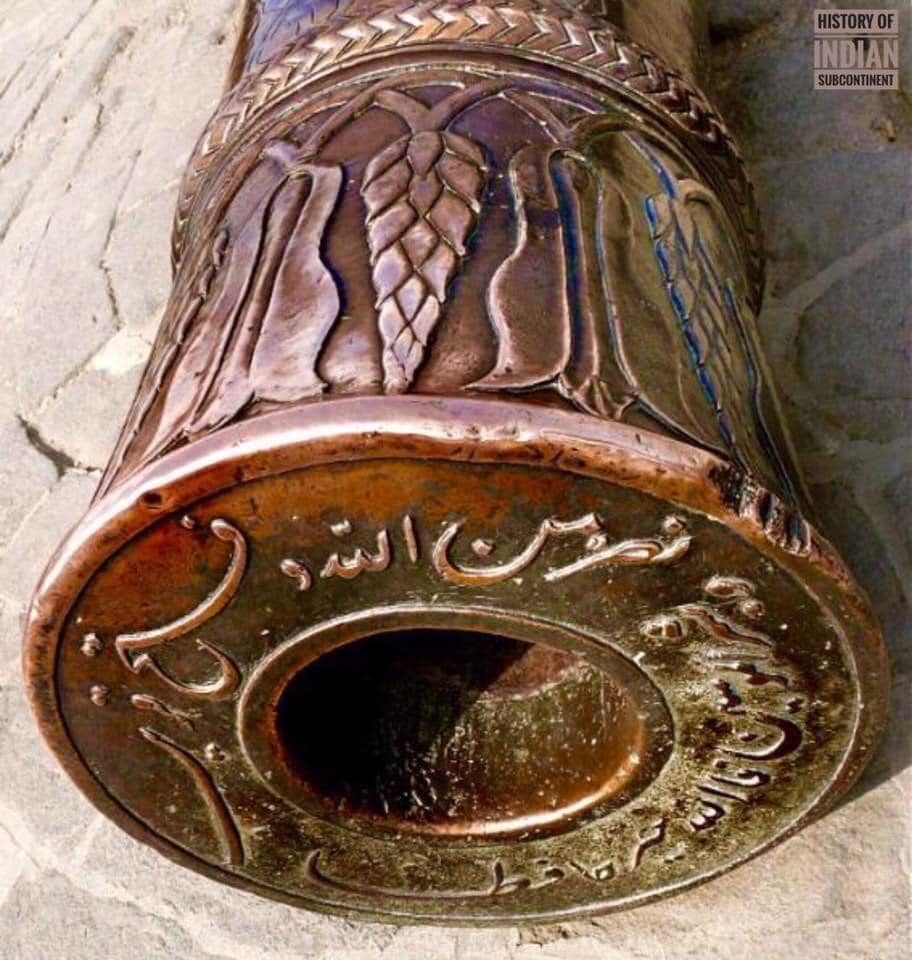Daulatabad Fort was captured by the Mughals in 1633. When Aurangzeb proclaimed himself Emperor, he had two important duties: to subjugate all his opponents and secure the border of his empire. Daulatabad Fort was an important post to control the Marathas.
To make this fort much stronger, he ordered to install the second biggest cannon made of a special alloy ever used in India, known as 'Mendha Toop' or 'Ram Head Cannon' The cannon was specially designed for Emperor Aurangzeb in Afghanistan by artisan Muhammad Hussain Arab. Aurangzeb's name is also engraved on the cannon.
There are a few animal figures carved on the cannon:
1. The rare end of the canon is shaped like a ram head. Why was Ram chosen as a symbol? Ram has the ability to fight continuously, with great force, without any tiredness.
2. The two lions on the cannon represent power and cruelty.
Special features of the cannon:
1. Shock absorber system.
2. Rotation only 180 degrees to cover a good angle; however, if attackers capture the cannon, they would not be unable to turn it towards the Daulatabad Fort.
3. Power to fire long distances, beyond the mountain rage. To keep enemies at a distance.
4. Positioned on the tower at the edge of the fort.
Another engraving on the front says, ﻧَﺼْﺮٌ ﻣِّﻦ ﺍﻟﻠَّﻪِ ﻭَﻓَﺘْﺢٌ ﻗَﺮِﻳﺐٌ. (Nasrun min Allahi, wa fat'hun qareeb).
Below are a few photographs.
अल्लामा फज़ले हक खैराबादी ( 1797 - 1861 ) वे प्रथम स्वतंत्रता-संग्राम 1857 की क्रांति के क्रांतिकारी एवं तर्कशास्त्री, उर्दू, अरबी व फारसी के प्रसिद्ध शायर थे।
==================================
हक का जन्म 1797 ई• में उत्तर प्रदेश के ज़िला सीतापुर के खैराबाद में हुआ था। उन्होंने शिक्षा दीक्षा धार्मिक रीति रिवाज़ो से प्राप्त की।
शिक्षा समापन के बाद वह खैराबाद में अध्यापन कार्य करने लगे और फिर 1816 ई• में उन्नीस साल की उम्र में दिल्ली ब्रिटिश सरकार में नौकरी करने लगे।
लेकिन एक ऐसा समय आया जब उन्होंने अंग्रेजों की नौकरी नहीं करने का मन बना लिया और 1831 में सरकारी नौकरी छोड़ दी। नौकरी छोड़ना के बाद वह दिल्ली के मुगल दरबार में कामकाज देखने लगें और शायरों की महफिल से वाबस्ता होने लगे।
1857 के दौर में जब ईस्ट इंडिया कंपनी के ज़ुल्मों की हद हो गई और हिन्दुस्तान के राजा महाराजा तथा नवाबों की रियासतों को हड़पना चाहा तो सभी राजा महाराजाओं तथा नवाबों और मौलवियों द्वारा अंग्रेजों को देश से बाहर निकालने का प्रयास किया गया और ज़बरदस्त विद्रोह की योजना बनाई गई। जिसका नेतृत्व क्रांति के महानायक मुगल सम्राट बहादुर शाह ज़फर द्वारा किया गया और अल्लामा फज़ले हक़ खैराबादी ने उनके साथ मिलकर अहम भूमिका निभाई।
अल्लामा फज़ले हक द्वारा अंग्रेजों के खिलाफ जेहाद का फतवा देकर मुस्लिम समुदाय से अंग्रेजों के खिलाफ विद्रोह में शामिल होने की अपील की। जिसका लाभ मुगल सम्राट और अन्य विद्रोही नेताओं को मिला।
मौलाना द्वारा फतवा जारी करने के बाद से ही अंग्रेजी प्रशासन द्वारा उनकी तलाश शुरू कर दी गई। क्रांति असफल हो जाने के बाद मौलाना बचते बचाते दिल्ली से खैराबाद तशरीफ ले आये। खैराबाद में अंग्रेजों को भनक लग गई। 30 जनवरी 1859 को उन्हें खैराबाद से गिरफ्तार कर लिया गया।
खैराबाद से उन्हें लखनऊ सेशन कोर्ट लाया गया और वहां उन पर मुकदमा चलाया गया। इस मुकदमें की पैरवी के लिए उन्होंने कोई वकील नियुक्त नहीं किया बल्कि मुकदमे की पैरवी उन्होंने खुद की। मौलाना पर अंग्रेजों के खिलाफ जेहाद का फतवा देने और लोगों को विद्रोह के लिए उकसाने, भड़काने के संगीन आरोप लगाये गये।
मुकदमे की सुनवाई के दौरान उन्होंने अपने जुर्म को कुबूल किया पर झूठ नहीं बोला और कहा -- हॉ वह फतवा सही है, वह मेरा लिखा हुआ था और आज भी मैं इस फतवे पर कायम हूं।
आरोपो को कुबूल करने के बाद उन्हें काले पानी की सज़ा सुनाई गई और सारी ज़ायदाद ज़ब्त करने का आदेश दिया गया। अंडमान-निकोबार ( सेलूलर जेल ) में ही 20 अगस्त 1861 में उनका देहांत हो गया। थे

Diwan-i-Khas in Agra Fort, Photograph circa 1890, India. A digitally restored photograph from the period by Photoglobe Co.
Built by Shah Jahan, this Hall of Private Audience hosted Mughal emperors' meetings. The famous Peacock Throne was once kept here, before Aurangzeb took it to Delhi. In the scene, Europeans leave the hall, natives work in gardens, highlighting its grand scale. The rosy sky was an imaginative addition by the printers, as this print is based on a black & white photograph. #History #India #Agra









